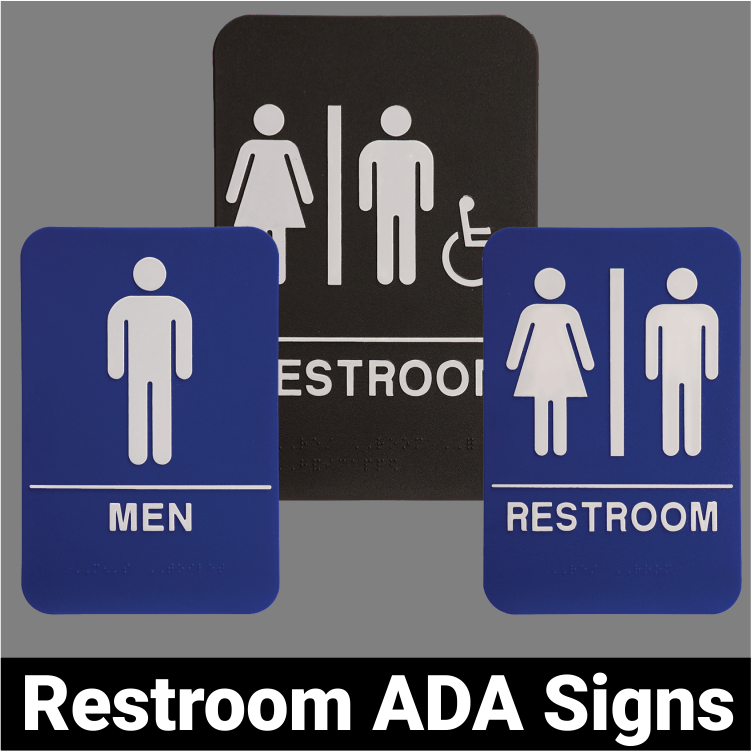The Duty of ADA Signs in Complying with Accessibility Criteria
The Duty of ADA Signs in Complying with Accessibility Criteria
Blog Article
ADA Signs: Ensuring Ease Of Access and Conformity in Public Spaces
ADA signage plays a crucial function in ensuring accessibility and compliance within public rooms, considerably contributing to a comprehensive atmosphere for people with handicaps. As we discover the nuances of ADA signs, from tactile functions to develop details, it's crucial to take into consideration just how these elements coalesce to promote the civil liberties of all customers.
Significance of ADA Signage
In modern culture, the relevance of ADA signage extends past plain compliance with lawful mandates to embody a commitment to inclusivity and accessibility for all people. These signs are crucial in creating atmospheres where individuals with impairments can browse public rooms with the exact same convenience and freedom as those without handicaps. By supplying clear and standard info, ADA signs makes certain that everyone can access centers, solutions, and details without barriers.
The value of ADA signage lies in its capability to improve the high quality of life for people with handicaps by promoting equal accessibility. It eliminates the barriers that could or else prevent their ability to participate completely in neighborhood life. These indicators offer as noticeable signs of an organization's commitment to variety and equality, reflecting wider social values that promote the legal rights and self-respect of all individuals.
Furthermore, ADA signs plays an important function in public safety and security. By leading people to leaves, toilets, and various other essential facilities, it makes certain that all people, regardless of physical ability, can evacuate safely throughout emergencies. In summary, ADA signage is not just a governing need however an effective device for cultivating a comprehensive and fair culture.
Crucial Element of Conformity

Positioning is important; indicators must be set up in locations that are easily visible and obtainable. Normally, signage needs to be placed between 48 and 60 inches from the ground to guarantee availability for both standing and wheelchair customers. Tactile components, such as Braille, are crucial for individuals with visual problems, providing important info in a non-visual style.
High-contrast colors in between the message and history are needed to improve readability for individuals with low vision. The ADA mandates details contrast proportions to guarantee clarity. Additionally, character size is an essential consideration, with minimum height needs determined by the viewing distance to make certain readability from numerous angles.
Design Factors To Consider for Accessibility
Creating easily accessible signage requires a thorough technique to ensure it meets the requirements of all customers, specifically those with specials needs. This involves thinking about numerous style aspects that improve readability and usability. Trick elements include these details the option of font, color comparison, and tactile attributes. Font styles must be sans-serif, with basic and clear letterforms, to help with very easy analysis. The size of the message is just as crucial, with ADA standards recommending a minimum height based on checking out distance to make sure readability.
Contrasting shades between text and background are crucial for visibility, especially for people with aesthetic disabilities. In addition, responsive aspects, such as Braille and elevated personalities, are essential for people that are blind or have reduced vision.
Moreover, the placement of signs plays a significant function in availability. Indications should be set up in locations that are unhampered and quickly obtainable. Making certain that signs is placed at suitable heights and angles makes it possible for all users, consisting of those utilizing wheelchairs, to engage with them properly.
Usual Blunders to Stay Clear Of

One more prevalent mistake is the incorrect placement of signs. ADA guidelines define precise elevation and place requirements to guarantee that indications are reachable and easily visible by all people, including those utilizing wheelchairs. Overlooking these standards not only hinders access yet additionally runs the risk of non-compliance with lawful standards.
In addition, insufficient comparison between text and history is a constant oversight. Ample contrast is necessary for readability, especially for individuals with low vision. Developers sometimes select colors that are visually attractive yet do not have the necessary comparison, rendering the message challenging to discern.
Lastly, some designers fall short to integrate tactile elements, such as Braille, which are crucial for individuals that are blind. Leaving out these functions not only causes non-compliance with ADA laws but additionally limits access for a segment of the population that counts on tactile info.
Future Trends in Signs
Advancements in technology and boosting understanding of inclusivity are shaping the future fads in signs style. Digital signage, for instance, is evolving to consist of real-time updates and interactive features, which can be essential in giving vibrant information in public rooms.
An additional you can try these out arising pattern is try this out the usage of increased truth (AR) to boost individual experience. AR-enabled signage can overlay electronic details onto the physical atmosphere, offering aesthetically impaired individuals with auditory or haptic comments. ADA Signs. This innovation not just boosts availability but likewise produces an engaging experience for all customers
Sustainability is also a considerable variable influencing signage fads. Environment-friendly products and energy-efficient lighting remedies are being prioritized to align with worldwide ecological goals. Furthermore, improvements in products science are resulting in the growth of even more durable and weather-resistant indications.
Final Thought
ADA signs plays an essential function in ensuring availability and conformity within public rooms by integrating responsive components, high-contrast colors, and strategic positioning. The adherence to ADA criteria not just promotes secure navigating for individuals with handicaps yet likewise signifies an organization's devotion to variety and inclusivity. By staying clear of typical errors and accepting future patterns, public spaces can remain to advance these worths, making certain that the rights and dignity of all individuals are valued and promoted.
ADA signs plays an essential role in guaranteeing access and conformity within public areas, significantly adding to a comprehensive atmosphere for individuals with disabilities. As we discover the subtleties of ADA signage, from responsive functions to develop complexities, it's essential to consider just how these aspects coalesce to promote the legal rights of all customers.In contemporary society, the value of ADA signs extends past simple conformity with lawful mandates to embody a dedication to inclusivity and availability for all individuals. By supplying clear and standardized info, ADA signage makes sure that everybody can access facilities, solutions, and details without barriers.
ADA signs plays a crucial role in assuring availability and compliance within public rooms by integrating responsive elements, high-contrast shades, and tactical positioning. (ADA Signs)
Report this page